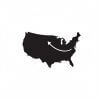



Queen Elizabeth II 25th Anniversary Coronation First Day Cover, South Georgia postmarked on June 2, 1978.
South Georgia
South Georgia is a barren, mountainous island in the South Atlantic, north of the Weddell Sea and 1200 miles east of Cape Horn. It is about one hundred miles long, with an area of 1600 square miles. It mostly comprises of snow-covered mountains and glacier filled valleys, but the several anchorages have historically provided relief for whalers. The 1000 in- habitants of the only village, Grytviken, departed with the end of whaling in 1965, leaving 20 British Antarctic Survey members. Claimed by Captain Cook in 1775 for Britain, it was also visited by another famous explorer, Shackleton, who died and was buried there.
The fur seal, depicted in this Omnibus issue, may be differentiated from its relatives the seal and sealion in a number of ways. Sealions have shorter pelts and prefer warmer waters; fur seals have rich fur, and propel themselves with their forepaws, using the rear ones as rudders, and preferring colder but not polar waters; and seals propel themselves with their rear legs, and tolerate polar waters. The South Georgia fur seal relies on krill for its staple diet, and also eats fish, Gentoo Penguins and squid. Its predators include killer whales, leopard seals and in warmer waters, sharks; and many are also killed in lighting among bulls. Their main enemy however, is man; in the early 19th Century, 30 sealing vessels, American, British and Russian hunted around the island, slaughtering on average 1,250,000 seals a year. The colonies were practically wiped out, and sealing stopped until late in the century, when tens of thousands more were killed. For a time, the species was believed to be extinct. Fortunately, however, a small colony survived on Bird Island, and now the animal is protected on all British islands in the South Atlantic.
The heraldic beast shown in this issue is the Panther of Henry VI, so named from the use of it in his badge. The Panther at St. George's Chapel on the roof bosses of the Queen's closet is also attributed to him, but it appeared earlier in the badge of Henry IV. Frequently regarded in the 16th Century as the female of the lion, it was given as sinister supporter to Queen Jane Seymour, and used by another of Henry VIII's wives, Catherine Parr, in her seal.
Shipping:
-
We ship via USPS, UPS or FedEx. At this time, we do not offer shipping to addresses with an APO/FPO or outside the continental United States.
Shipping Time:
Orders are normally shipped from our warehouse within 24 - 48 business hours of order placement. Please allow 7 - 10 business days for delivery after your order has shipped. Delivery times are estimated and we do not provide money-back guarantee for any shipping option other than FedEx Express or UPS Next Day.
Terms of Use and Security
-
We use cookies to store visitors preferences, record session information, such as items that consumers add to their shopping cart, record user-specific information on what pages users access or visit, alert visitors to new areas that we think might be of interest to them when they return to our site. If you do not want to receive e-mail from us in the future, please let us know by sending us an e-mail. If you supply us with your postal address on-line you may receive periodic mailings from us with information on new products, special pricing and services or upcoming events. If you do not wish to receive such mailings, let us know by sending us an e-mail. Please provide us with your exact name and address. Persons who supply us with their telephone numbers on-line will only receive telephone contact from us with information regarding orders they have placed on-line. With respect to security: We have appropriate security measures in place in our physical facilities to protect against the loss, misuse or alteration of information that we have collected from you at our site. If you feel that this site is not following its stated information policy, you may contact us at your discretion.
Returns & Replacements
-
We accept returns within 30 days of the date of purchase unless otherwise stated on the item's page. In order to return an item, please contact us for a Return Authorization Number. Once the Return Authorization Number is acquired, you have 30 days to return the item(s). All returned items must be unused and in new condition in their original packaging including all hardware and instructional components. Items are also subject to a 20% restocking fee. Although if you are a repeat customer who purchased from our website before, we are happy to waive the restocking fee.
Any returned item deemed not to fall within the preceding criteria will be returned with no credit issued at the customer's expense. Once your return has been inspected please allow 15 days for the credit to be applied to the credit card used for purchase. The initial cost of shipping is not eligible for a refund. Buyer pays for return shipping. To request your Return Authorization Number, please follow these steps:
-
1. Read and agree to the Returns Policy and Procedure above.
-
2. Email us at cs@phenomstores.com. We will need your order number and the Item ID number of the product you wish to return.
Refused Orders - Should you decide that you wish to refuse receipt of an item when delivered by UPS, USPS or any other common carrier and legitimately ordered from us, credit will be issued for the item, minus shipping and a restocking charge of 20%.Exchanges - In order for us to do the exchange we would need to refund your payment, then you would need to make another purchase transaction with us for the item that you like within 7 days of your exchange request. We're asking that you return the item you bought from us within 30 days along with a tracking number so we both know that your return reached us. We are not responsible for lost or stolen items. All returned items must be unused and in new condition in their original packaging including all hardware and instructional components. Any returned item deemed not to fall within the preceding criteria will be returned with no credit issued at the customer's expense. You are responsible for the return shipping cost. We also charge a 10% restocking fee for exchanges. Once we received and inspected the item we will credit** your payment. Please take note, our inventory changes constantly so the item may not be available at the time of your request.
**A store credit will be issued on orders returned totaling less than $5.
Damaged, Defective and Wrong Item(s) - It is your responsibility that the item(s) you received are undamaged and the correct item(s). Please examine the shipping box and all contents immediately upon receipt for any signs of damage, defect or wrong item(s). All claims must be initiated within 7 days of delivery and send us an email so we can further assist you.
Still have questions? Please don't hesitate to contact us by sending us an email to cs@phenomstores.com or by phone at 608-571-7033.
FAQ
When do I expect my order to ship out?
Our normal shipping lead times can take up to 72 hours after your order is received. However, due to unprecedented demand brought on by COVID-19 our shipping times have been extended. This is due to logistical issues that our shipping carriers are experiencing that is outside our control. Rest assured, we're doing everything we can to ship your order as soon as it's received.
How will I know my order has shipped?
As soon as your order is packed and labeled, we will email you a shipment confirmation with the tracking number so that you're able to track your order. You can look up the status of your order by entering the tracking number found on the bottom of our web page under "Track Order Status". You can also look up the shipment status of your order by entering your shipment tracking number at USPS.com, UPS.com or FedEx.com.
How much does shipping cost?
Our shipping costs vary depending on the item you're purchasing. Most items are eligible for our FREE shipping if your purchase totals $59 and over. And for items that are excluded from FREE shipping like bulk or oversized items, we offer FIXED shipping rate or prevailing market prices.
Some of the items I ordered are missing. What should I do?
Please reach out to us when you have items that are missing when you originally placed your order. This happens either because,
1. The missing items are on backorder or
2. The missing items are still on its way but due to service delays from our shipping carrier (ie UPS, FedEx) your package may take longer than expected.
How soon after can I cancel my order?
Unfortunately, we cannot cancel an order once an order is placed. This is because your order is automatically placed in queue to ship out once an order is received.
What is the best way to reach you when I have a question?
Our customer service phone and chat lines are normally open from 8:30 am to 5:30 pm CST. However, there are times when we can't be reached because all our customer service agents are helping other customers. If this happens, please leave us a voicemail at 608-571-7033 or write us a message on our "Contact Us" page and we will get back to you as soon as possible.
What happens when I "Pre-Order" an item?
When you "Pre-Order" an item that is out of stock, you will be notified when we have the item in stock again. Our "Pre-Order" (or Wait-List) doesn't guarantee that your order will be fulfilled but we will do our best to make that happen.
You're also under NO obligation to purchase when you sign up for "Pre-Order".



